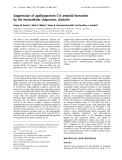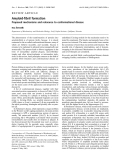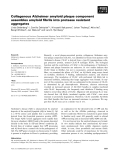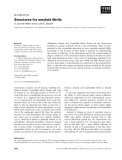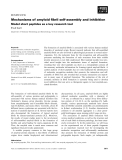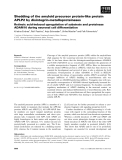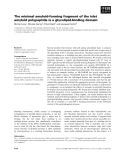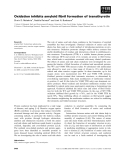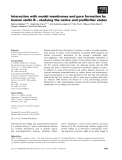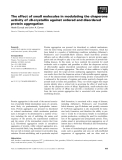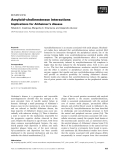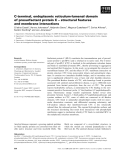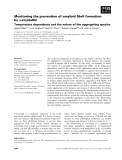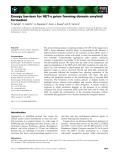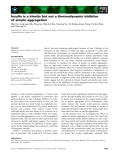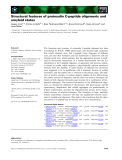
Amyloid formation
-
The effect of the extracellular chaperone, clusterin, on amyloid fibril formation by lipid-free human apolipoprotein C-II (apoC-II) was investigated. Sub-stoichiometric levels of clusterin, derived from either plasma or semen, potently inhibit amyloid formation by apoC-II. Inhibition is dependent on apoC-II concentration, with more effective inhibition by clusterin observed at lower concentrations of apoC-II. The average sedimentation coefficient of apoC-II fibrils formed from apoC-II (0.3 mgÆmL)1) is reduced by coincubation with clusterin (10 lgÆmL)1). ...
 6p
6p  system191
system191
 01-06-2013
01-06-2013
 37
37
 3
3
 Download
Download
-
The phenomenon of the transformation of proteins into amyloid-fibrils is of interest, firstly, because it is closely connected to the so-called conformational diseases, many of which are hitherto incurable, and secondly, because it remains to be explained in physical terms (energetically and structurally). The process leads to fibrous aggregates in the form of extracellular amyloid plaques, neuro-fibrillary tangles and other intracytoplasmic or intranuclear inclusions.
 10p
10p  research12
research12
 01-06-2013
01-06-2013
 33
33
 4
4
 Download
Download
-
Recently, a novel plaque-associated protein, collagenous Alzheimer amy-loid plaque component (CLAC), was identified in brains from patients with Alzheimer’s disease. CLAC is derived from a type II transmembrane colla-gen precursor protein, termed CLAC-P (collagen XXV). The biological function and the contribution of CLAC to the pathogenesis of Alzheimer’s disease and plaque formation are unknown.
 0p
0p  awards
awards
 06-04-2013
06-04-2013
 31
31
 2
2
 Download
Download
-
Alzheimer’s disease and Creutzfeldt–Jakob disease are the best-known examples of a group of diseases known as the amyloidoses. They are char-acterized by the extracellular deposition of toxic, insoluble amyloid fibrils. Knowledge of the structure of these fibrils is essential for understanding the process of pathology of the amyloidoses and for the rational design of drugs to inhibit or reverse amyloid formation.
 12p
12p  dell39
dell39
 27-03-2013
27-03-2013
 34
34
 4
4
 Download
Download
-
The formation of amyloid fibrils is associated with various human medical disorders of unrelated origin. Recent research indicates that self-assembled amyloid fibrils are also involved in physiological processes in several micro-organisms. Yet, the molecular basis for the recognition and self-assembly processes mediating the formation of such structures from their soluble protein precursors is not fully understood.
 8p
8p  dell39
dell39
 27-03-2013
27-03-2013
 41
41
 5
5
 Download
Download
-
Cleavage of the amyloid precursor protein (APP) within the amyloid-beta (Ab) sequence by the a-secretase prevents the formation of toxic Abpep-tides. It has been shown that the disintegrin-metalloproteinases ADAM10 and TACE (ADAM17) act asa-secretases and stimulate the generation of a soluble neuroprotective fragment of APP, APPsa.
 13p
13p  dell39
dell39
 27-03-2013
27-03-2013
 34
34
 5
5
 Download
Download
-
Several proteins that interact with cell surface glycolipids share a common fold with a solvent-exposed aromatic residue that stacks onto a sugar ring of the glycolipid (CH–pstacking interaction). Stacking interactions between aromatic residues (p–pstacking) also play a pivotal role in the assembly pro-cess, including many cases of amyloid fibril formation.
 12p
12p  inspiron33
inspiron33
 23-03-2013
23-03-2013
 37
37
 4
4
 Download
Download
-
The role of amino acid side chain oxidation in the formation of amyloid assemblies has been investigated. Chemical oxidation of amino acid side chains has been used as a facile method of introducing mutations on pro-tein structures. Oxidation promotes changes within tertiary contacts that enable identification of residues and interactions critical in stabilizing pro-tein structures.
 7p
7p  inspiron33
inspiron33
 23-03-2013
23-03-2013
 31
31
 3
3
 Download
Download
-
Human stefin B, from the family of cystatins, is used as a model amyloido-genic protein in studies of the mechanism of amyloid fibril formation and related cytotoxicity. Interaction of the protein’s prefibrillar oligo-mers⁄aggregates with predominantly acidic phospholipid membranes is known to correlate with cellular toxicity.
 12p
12p  media19
media19
 06-03-2013
06-03-2013
 53
53
 4
4
 Download
Download
-
Amyloid-b(Ab) aggregation and amyloid formation are key pathological features of Alzheimer’s disease, and are considered to be two of the major contributing factors to neurodegeneration and dementia. Identification of small molecule inhibitors that are orally available, have low toxicity and high central nervous system bioavailability is one approach to the potential development of a disease-modifying treatment for Alzheimer’s disease.
 12p
12p  media19
media19
 06-03-2013
06-03-2013
 50
50
 2
2
 Download
Download
-
Protein aggregation can proceed via disordered or ordered mechanisms, with the latter being associated with amyloid fibril formation, which has been linked to a number of debilitating conditions including Alzheimer’s, Parkinson’s and Creutzfeldt-Jakob diseases. Small heat-shock proteins (sHsps), such as aB-crystallin, act as chaperones to prevent protein aggre-gation and are thought to play a key role in the prevention of protein-mis-folding diseases.
 13p
13p  media19
media19
 05-03-2013
05-03-2013
 41
41
 4
4
 Download
Download
-
Acetylcholinesterase is an enzyme associated with senile plaques. Biochemi-cal studies have indicated that acetylcholinesterase induces amyloid fibril formation by interaction throughout the peripherical anionic site of the enzyme forming highly toxic acetylcholinesterase–amyloid-bpeptide (Ab) complexes.
 8p
8p  media19
media19
 05-03-2013
05-03-2013
 41
41
 2
2
 Download
Download
-
Surfactant protein C (SP-C) constitutes the transmembrane part of prosurf-actant protein C (proSP-C) and isa-helical in its native state. The C-termi-nal part of proSP-C (CTC) is localized in the endoplasmic reticulum lumen and binds to misfolded (b-strand) SP-C, thereby preventing its aggregation and amyloid fibril formation.
 12p
12p  media19
media19
 05-03-2013
05-03-2013
 29
29
 4
4
 Download
Download
-
The molecular chaperone,a-crystallin, has the ability to prevent the fibril-lar aggregation of proteins implicated in human diseases, for example, amyloidbpeptide anda-synuclein. In this study, we examine, in detail, two aspects of a-crystallin’s fibril-suppressing ability: (a) its temperature dependence, and (b) the nature of the aggregating species with which it interacts.
 16p
16p  media19
media19
 05-03-2013
05-03-2013
 35
35
 2
2
 Download
Download
-
Alzheimer’s disease (AD) is a neurological disorder characterized by the presence of amyloidb(Ab) peptide fibrils and oligomers in the brain. It has been suggested that soluble Ab oligomers, rather than Ab fibrils, contribute to neurodegeneration and dementia due to their higher level of toxicity.
 12p
12p  vinaphone15
vinaphone15
 28-02-2013
28-02-2013
 35
35
 2
2
 Download
Download
-
The prion-forming domain comprising residues 218–289 of the fungal prion HET-s forms infectious amyloid fibrils at physiological pH. Because a high-resolution molecular model for the structure of these fibrils exists, it constitutes an attractive system with which to study the mechanism of amy-loid assembly.
 12p
12p  vinaphone15
vinaphone15
 25-02-2013
25-02-2013
 23
23
 3
3
 Download
Download
-
One of the most important pathological features of type 2 diabetes is the formation of islet amyloid, of which the major component is amylin pep-tide. However, the presence of a natural inhibitor such as insulin may keep amylin stable and physiologically functional in healthy individuals. Some previous studies demonstrated that insulin was a potent inhibitor of amylin fibril formationin vitro, but others obtained contradictory results.
 7p
7p  viettel02
viettel02
 22-02-2013
22-02-2013
 43
43
 3
3
 Download
Download
-
Human transthyretin (hTTR) is one of several proteins known to cause amyloid disease. Conformational changes in its native structure result in aggregation of the protein, leading to insoluble amyloid fibrils. The trans-thyretin (TTR)-related proteins comprise a protein family of 5-hydroxyiso-urate hydrolases with structural similarity to TTR.
 13p
13p  viettel02
viettel02
 22-02-2013
22-02-2013
 41
41
 3
3
 Download
Download
-
The formation and structure of proinsulin C-peptide oligomers has been investigated by PAGE, NMR spectroscopy and dynamic light scattering. The results obtained show that C-peptide forms oligomers of different sizes, and that their formation and size distribution is altered by salt and divalent metal ions, which indicates that the aggregation process is medi-ated by electrostatic interactions.
 10p
10p  viettel02
viettel02
 19-02-2013
19-02-2013
 42
42
 3
3
 Download
Download
-
The conformational conversion of prion protein (PrP) from a native con-formation to the amyloid form is a hallmark of transmissible spongiform encephalopathies. Conversion is usually monitored by fluorescent dyes, which bind generic amyloids and are less suited for living cell imaging.
 13p
13p  mobifone23
mobifone23
 21-01-2013
21-01-2013
 40
40
 4
4
 Download
Download
CHỦ ĐỀ BẠN MUỐN TÌM









